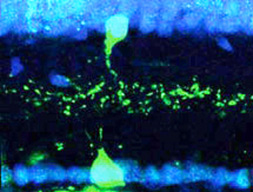 |
A VG3 amacrine cell
(top, in green) is shown superimposed with an
object motion detector
cell (bottom, green). Each of the neurons is
expressing sidekick-2, an adhesion molecule that allows the two neurons
to find each other and
connect. |
When we move our head, the whole visual world moves across our eyes. Yet we can still make out a bee buzzing by or a hawk flying overhead, thanks to unique cells in the eye called object motion sensors. A new study on mice helps explain how these cells do their job, and may bring scientists closer to understanding how complex circuits are formed throughout the nervous system. The study was funded by the National Institutes of Health, and was published online in Nature.
That's the press release from NIH.
“Understanding how neurons are wired together to form circuits in the eye is fundamental for advancing potential new therapies for blinding eye diseases,” said Paul A. Sieving, M.D., Ph.D., director of NIH’s National Eye Institute (NEI). “Research aimed at regenerating photoreceptors, for example, is enriched by efforts to understand the circuitry in the eye.”
Object motion sensors are one of about 30 different types of retinal
ganglion cells (RGCs) in the retina, the light-sensitive tissue at the
back of the eye. These cells are unique because they fire only when the
timing of a small object’s movement differs from that of the background;
they are silent when the object and the background move in sync.
Researchers believe this is critical to our ability to see small objects
moving against a backdrop of complex motion.
The cells in the retina are wired up like an electrical circuit.
Vision begins with photoreceptors, cells
that detect light entering the
eye and convert it into electrical signals. Middleman neurons, called
interneurons, shuttle signals from photoreceptors to the RGCs. And each
RGC sends the output visual information deeper into the brain for
processing. This all takes place within fractions of a second, so the
scientists were surprised to discover that before it reaches object
motion sensors, visual information about object motion takes a detour
through a unique type of interneuron. Their results represent an ongoing
effort by scientists to map out complex circuits of the nervous system.
Read more.


No comments:
Post a Comment